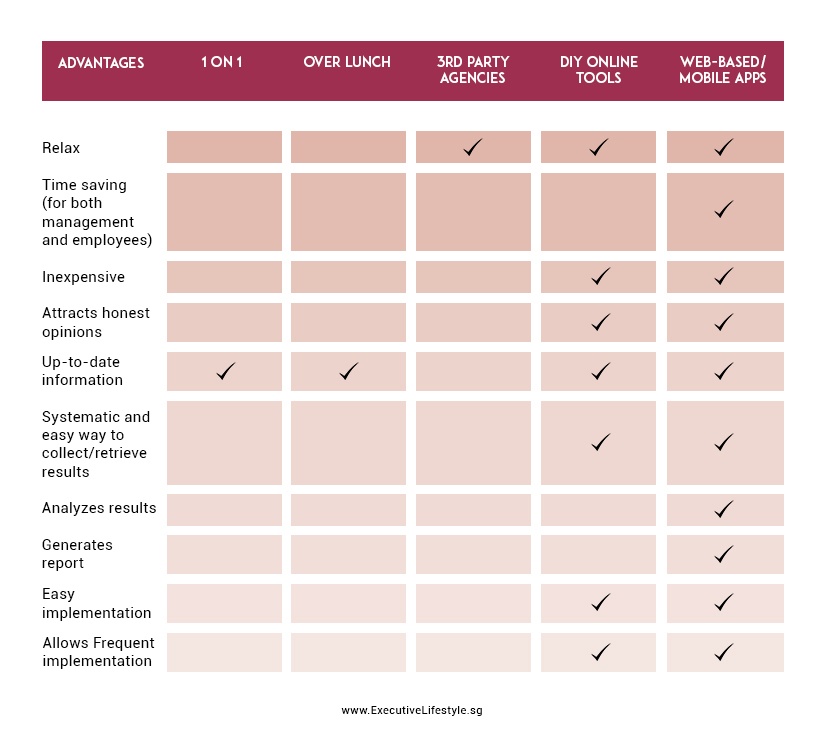4 Ways To Boost The Effectiveness Of Team Feedback
 Contributed by
Regina Soh
November 16, 2015
Contributed by
Regina Soh
November 16, 2015

Many companies know the importance of receiving feedback. Leaders know that feedback gives them live insights into what is happening in the workplace, what works, what does not and what their people really yearn. With results from feedback, appropriate actions can be taken to make the office a better and more exciting place to work in.
Armed with the knowledge of what motivates and drives their employees, companies can also better channel resources to grow and develop the team which is an important driver for gaining competitive advantage.
Many companies know the importance of receiving feedback. Leaders know that feedback gives them live insights into what is happening in the workplace, what works, what does not and what their people really yearn. With results from feedback, appropriate actions can be taken to make the office a better and more exciting place to work in. Armed with the knowledge of what motivates and drives their employees, companies can also better channel resources to grow and develop the team which is an important driver for gaining competitive advantage.
The thing is, feedback is not a one-size fits all solution to organizations who sincerely wants to change their workplace for the better. Depending on the type of information you want to obtain, different questions should be asked. For instance, you observed that your team looked rather burnt out. You want to know if they are having a tough time between work and family or if it’s just work.
Some of the areas of concern are:
- Wellness: Are they healthy and fit to take on the everyday challenges?
- Work-Life Balance: Are they having enough personal and family time?
- Professional Development: Do they have the right training and help to handle and excel in their work?
- Personal Growth: Are they in a state of positive mindset? Do they learn soft skills from work that could be applied out of work?
- Happiness: How happy are they coming to work? (Simple, yet it’s a significant driver of turnover).
- Social Connections: How are they getting along with colleagues and the team? Is that one person having difficulty blending in with the rest?
Why Is It Important To Get Updated With Employee’s Areas Of Concern?
If you have left a position, at bare minimum once, think back on why you left that job? It’s very likely one or more of the areas of concern mentioned above weren’t doing so well for you which prompted you to leave for a greener pasture.
Such departures, when it re-occurs for some employees in your organization, presents a high turnover rate. This in turn translate to high costs, productivity and time loss as the process of recruiting, training and exits repeats itself. And all these costs, which I termed ‘avoidable costs,’ could really be minimized or, as the name suggests, avoided.
To tackle the areas of concern effectively, you would have to get your hands dirty and explore by asking your team, your organization. There’s no shortcuts, and never play the guessing game by assuming what you think is what your employees most probably feel and experience.
How To Ask and Get Genuine Opinions
There are various ways you could conduct a feedback session. Here we list out the possible options and how they compare against each other.

No matter what options you use, it will be more effective to conduct both open (team) feedback and closed (anonymous) feedback. They complement each other.
Team Feedback
As the name suggest, it’s everything about your team. Team feedback is used in instances when you want to gather information about
- the setbacks your team members are facing
- suggestions they may have
- achievements that they are proud of (it’ll be good to provide some praise in this case)
- your leadership
Anonymous Feedback
When it comes to finding out answers and true reflection of sensitive topics that are often hard to obtain, make use of anonymous feedback. As employees are posed sensitive questions that touch on the areas of concern discussed above, most of them will hold back in giving you their genuine comments. Only a few brave souls will be more vocal.
If you have decided to use online tools that are readily available (e.g. Google Forms, Survey Monkey, TypeForm), find out how and what to ask. Learning to build an environment that is comfortable for your team members to give honest opinions is also important. We’ve covered that in
Factors Affecting Effectiveness of Feedback
Implementing feedback is just one step done. Behind the scenes, there are factors to consider in order to derive accurate insights.
First, I would like to highlight the most obvious but yet somehow overlooked action.
1. Do Something
What’s the main purpose of you implementing employee feedback? Assuming we are on the same page, feedback is use to gather information and opinions so that we get a clear direction from the group of subjects we are interested in.

With the data and insights, do something and make changes for a better outcome. Say for example, through feedback, you get to know your employees that are not faring well in wellness. From that, perhaps you plan to provide free membership to gyms nearby your office. Turns out it was a right action because your employees date each other and go to the gym to get fit together! They’re now on even closer terms, working and playing together.
Ok, I admit this is an ideal scenario and it might not be easy to get it right in reality. But you get the point. Do something!
And when you decide to do something, it’s important to have a systematic way to follow-up on the change implementation. For instance, you could form a group to take charge of the feedback insights and take actions. Rotate the group members so that your employees have a chance to determine the changes they want to see happen.
2. Do It More Frequently
The number of times you do the feedback over a period of time is also key to how accurate and reflective the data is of the current situation in your team. The longer interval you have in between each survey, the more dilute the insights are.
A year-end survey is one good example. The results gathered from year end surveys are only representative of what the employee is feeling, seeing, and experiencing during that moment or week that they are taking the survey. It could be that the employee happens to get really sad because of some workplace issues before she takes the survey. This would greatly alter her input.
Since year-end surveys results could be dependent on what the employee is feeling at the time of doing it, it makes sense to do feedbacks in small intervals, say weekly or bi-weekly. Each short feedback phase allows you to collect information over a longer period and presents a bigger picture of the workplace situation more accurately.
3. Share The Findings
After you get the results from the feedback loop, don’t keep the information to yourself. Share it with your team. The idea is tocommunicate with a strategyas ‘information affects behaviour’.
It is beneficial to make everyone aware of what’s working and what’s not for the organization/team. The fact is: if information is fed to us frequently and routinely enough, we begin to act on it as if it were an accurate sample of the greater reality …
For instance, if we know through team feedback that we are lacking in teamwork, then we would announce it openly and let all relevant parties play a part in finding innovative and effective ways to level up teamwork.
Although sharing of results is encouraged, we do not want the amount of shared information to clutter and overwhelm the team such that it translate into noises. Be selective with the data to be shared.
4. Deliberate Practice
You may think to yourself, “what’s there to practise?” In order to make feedback effective, it should not be one-way traffic. Aside from team members providing input to the leaders, the leaders should also be doing the same, forming a feedback loop.
After sharing the results, there might be cases where some candid employees put forward some emotionally risky questions. You will be surprised that the incoherent answers that leaders give to team members often confuse them, instead of reinforcing their understanding. When leaders are posed some difficult questions from their people, a lot is going through their mind and sometimes it is not easy to assess if certain information should be revealed.
However, if the leaders/executives are deliberately trained to address these issues professionally, respectfully and without any discrepancies in their approach, they will be sending the same signal across the organization in areas that the employees are concerned with. The feedback that leaders provide to the employees are then seen to be uniform, transparent and sincere which contributes to the overall effectiveness of the feedback loop!
Start taking the four actions listed above and experience the improvements in internal communication.
Let us know how this article works for you. We’d be really interested to hear it. If you have observed other ways to make your feedback system effective, share it with us too!
Written By Anna Danes
Visit the Invipulse page to find out more about Regina's work.
This article was first published on Invipulse blog and has been reposted on Executive Lifestyle with the permission of the author.
Did you enjoy this post? Please comment, like and share!











Sorry, the comment form is closed at this time.